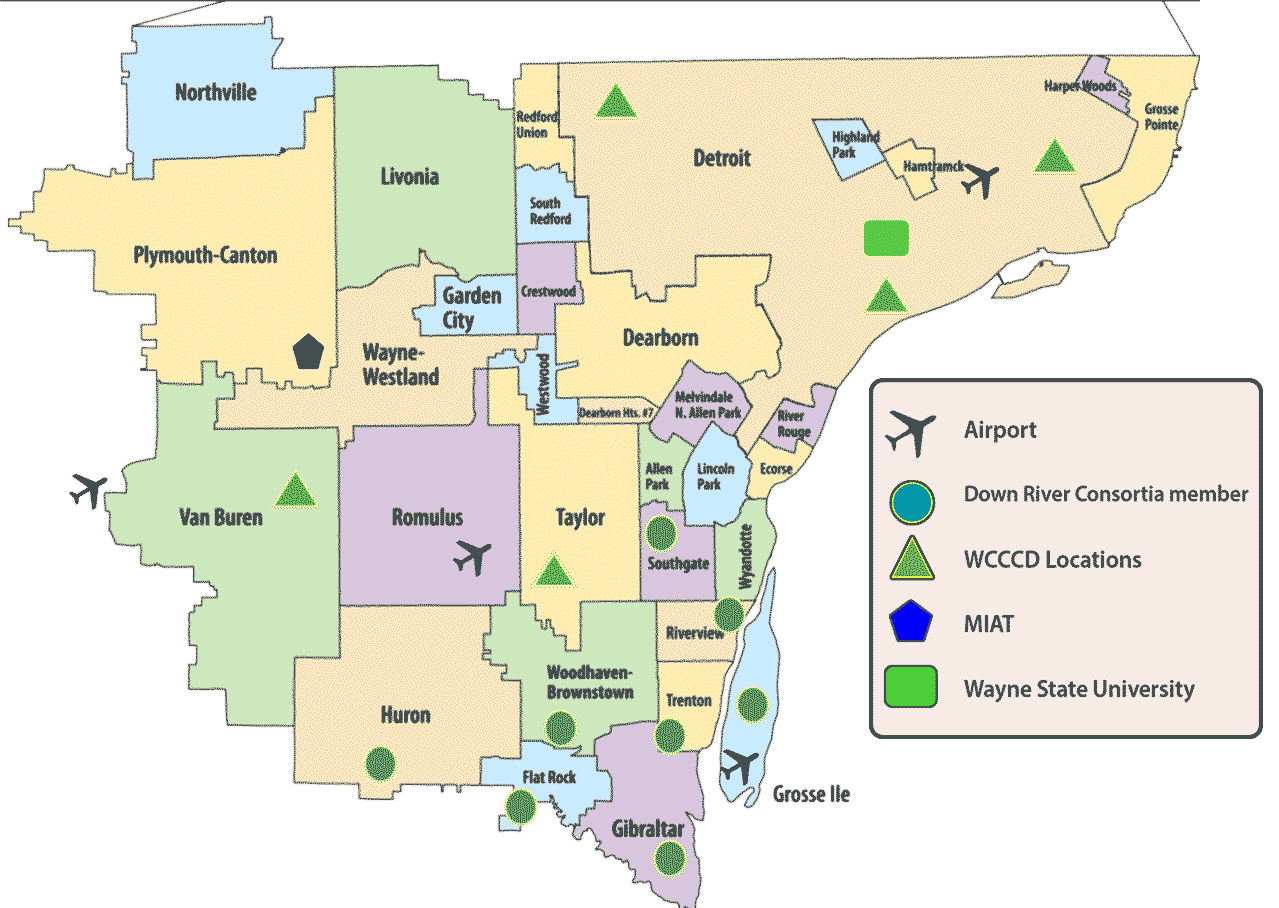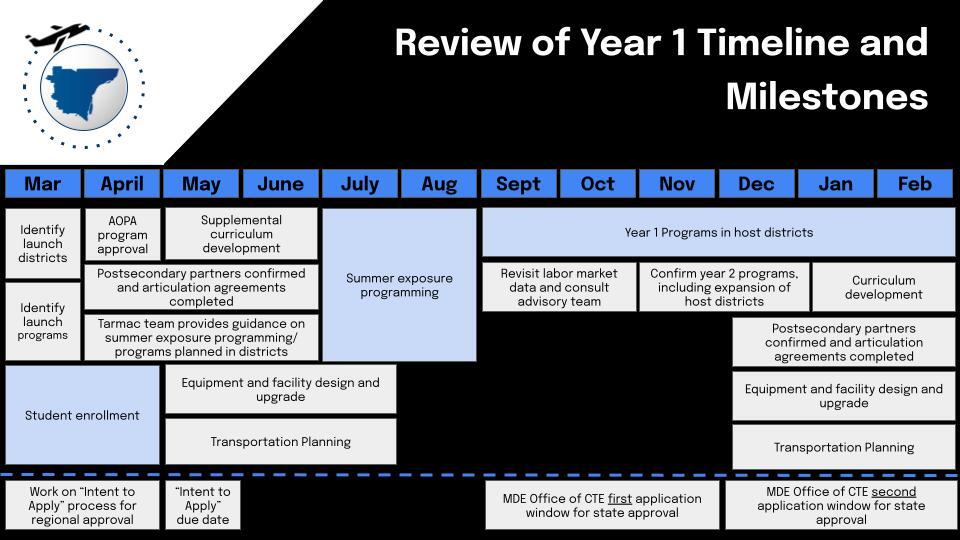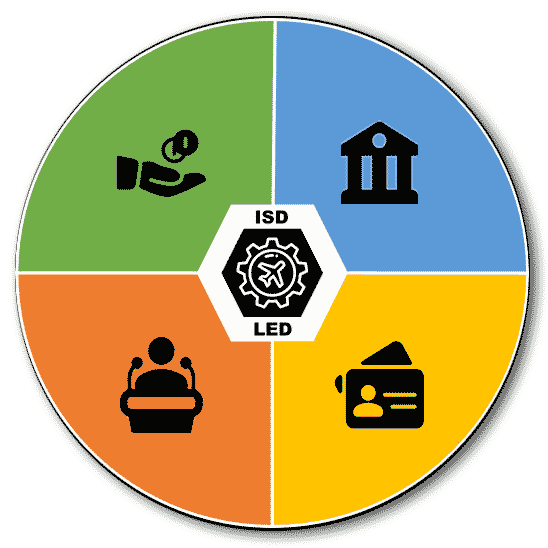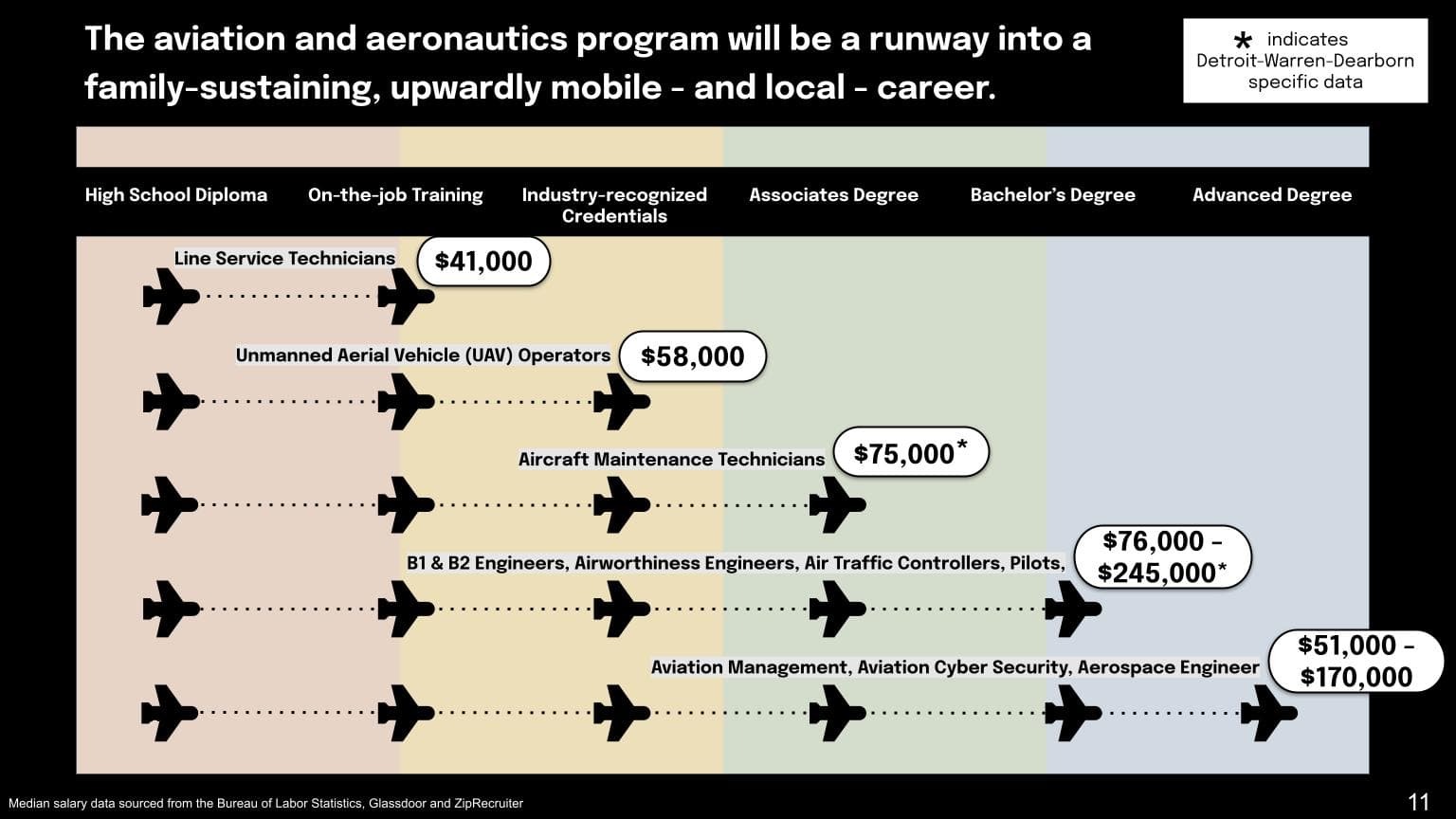Wayne County Aviation and Aeronautics CTE Program
Launching Careers. Lifting Futures.
Wayne RESA, in partnership with Wayne County and the Wayne County Airport Authority, is developing an exciting new Aviation and Aeronautics Career and Technical Education (CTE) Program. This innovative countywide initiative is designed to introduce middle and high school students—especially those underrepresented in STEM fields—to high-demand careers in aviation, from piloting and aircraft maintenance to autonomous systems and beyond.
Industry Outlook
The aviation and aerospace industries are undergoing a period of unprecedented global growth. Career opportunities across the sector—both in the air and on the ground—are expanding rapidly, with strong demand anticipated over the next two decades.
According to Boeing’s U.S. projections, the commercial aviation workforce will require:
- 127,000 new pilots
- 125,000 new maintenance technicians
- 177,000 new crew members
The U.S. Bureau of Labor Statistics also forecasts
- 12% growth for aircraft mechanics and service technicians
- 10% growth for avionics technicians by 2030
Beyond these roles, additional aviation-related careers—such as aerospace engineers, air traffic controllers, and airport hospitality staff—are also expected to see sustained demand.
Understanding Local Assets Map

Timeline & Milestones

Review of Year 1 Timeline and Milestones
March
- Identify launch districts
- Identify launch programs
- Begin student enrollment
- Work on “Intent to Apply” process for regional approval
April
- AOPA program approval
- Tarmac team provides guidance on summer programming
- Continue student enrollment
May
- Supplemental curriculum development
- Postsecondary partners confirmed and articulation agreements completed
- “Intent to Apply” due date
June
- Finalize equipment and facility design and upgrades
- Transportation planning begins
July
- Summer exposure programming
August
- Summer exposure programming continues
September
- Revisit labor market data and consult advisory team
October
- MDE Office of CTE first application window for state approval
November
- Confirm Year 2 programs, including expansion of host districts
December
- Year 1 programs in host districts continue
January
- Postsecondary partners confirmed and articulation agreements completed
- Equipment and facility design and upgrade
- Transportation planning
February
- Curriculum development
- MDE Office of CTE second application window for state approval
An Untapped Market: Why Now?
Detroit Metropolitan Airport (DTW) and Willow Run Airport (YIP) are two of Michigan’s most important economic engines, collectively supporting more than 86,000 jobs across the state. With the global aviation industry projected to need more than 2 million new professionals by 2042, Wayne County is uniquely positioned to contribute to that workforce—if the right systems are in place.
Despite this opportunity, many local students, especially those from historically underrepresented backgrounds, lack access to high-quality aviation career pathways. The Wayne County Aviation and Aeronautics CTE Program is designed to close this gap by offering immersive learning, hands-on training, and direct industry engagement that begins in high school and connects seamlessly to college and career.
What Students & Parents Can Expect
This program creates a clear path from classroom to career in one of today’s most exciting fields. It empowers students to build valuable skills, earn college credits, and connect with potential employers—all while still in school.
- Hands-on Training in aviation technology, piloting, and aircraft repair
- Real-World Experience through simulators, software, and industry-grade equipment
- Dual Enrollment Opportunities with colleges and universities
- Access to Industry & Military Partnerships for mentorship and career pathways
- Free Transportation to program sites
Diversity & Inclusion: Expanding Opportunities
- Women make up just 12% of the U.S. aviation workforce
- In 2021, 93% of U.S. aircraft pilots and flight engineers were white
- Fewer than 4% of airline pilots in the U.S. are African American
This program will prioritize expanding access to underrepresented groups through intentional outreach, inclusive curriculum design, and strong community partnerships.
Three Regional Hubs
The program will be anchored by three regional “Hubs” at:
- Davis Aerospace High School (City of Detroit – Coleman A. Young International Airport)
- Willow Run Airport
- Grosse Ile Municipal Airport
Stakeholder Engagement
We are proud to have built a diverse coalition of stakeholders committed to the success of this program
School District Partners
- All 33 Wayne County public school districts have committed to program participation.
Government & Policy Partners
- City of Detroit
- City of Romulus
- Michigan Aeronautics Commission
- Michigan Department of Transportation
- Michigan Economic Development Corporation
- Wayne County Executive’s Office
Education & Workforce Partners
- AirSpace Link
- AVflight
- Coleman A. Young International Airport
- Delta
- Detroit Employment Solutions Corporation
- Detroit Public Schools Community District
- Detroit Region Aerotropolis
- Downriver Career Technical Consortium
- Federal Aviation Administration
- Grosse Ile Airport
- Hall’s Flying Services
- Henry Ford College
- Industry & Airport Partners
- K-12 Collaborative
- Metro Airport Transportation
- MiSTEM Network
- National Academies Foundation
- Romulus Community Schools
- Schoolcraft College
- SEMCA (Southeast Michigan Community Alliance)
- Wayne County Airport Authority
- Wayne County Community College District
- Wayne State University
- Willow Run Airport
Accomplishments and Future Plans
Progress Made
- Secured funding and purchased drones for classroom-based STEM and aviation instruction across Wayne County districts.
- Launched professional development and training for Wayne County educators and leaders on the AOPA curriculum, building capacity to implement aviation and aeronautics programming.
- Convened a countywide advisory group of district leaders, postsecondary institutions, community organizations, and aviation employers
- Hosted a Knowledge Visit with over 20 education and industry leaders
- Attended the AOPA National Conference to build national connections
- Visited leading programs:
- Alabama Aviation & Aeronautics High School (Bessemer, AL)
- Aviation Institute of Maintenance (Atlanta, GA)
- Developed a cross-sector governance structure to guide implementation and ensure long-term quality
- Received commitments from all 33 school districts in Wayne County, including identification of main contacts for each
- Created regional consortia to coordinate curriculum, instruction, and program delivery across districts
- Hosted curriculum selection meeting (Jan. 27) to finalize course offerings and identify host districts for hands-on instruction
- Submitted a competitive application for an FAA grant, demonstrating proactive pursuit of federal investment. Note: Grant decision pending
-
Cross-Sector Collaboration
-
K-12 Collaborative Core Principles
-
Sustainable Funding
-
Aviation and Aeronautics Career Pathways
Cross-Sector Collaboration
Building the Future of Aviation Through Cross-Sector Collaboration

Graphic shown above: Visual representation of cross-sector contributions and benefits (ISD-Led Model)
Philanthropic Institutions
Gives
- Resources & Funding
Gets
- Re-imagined school-to-career journey
- Increased student participation in STEM
- Decreased barriers to economic success for underrepresented students
Secondary & Postsecondary Systems
Gives
- Course articulation for dual credit
- Partnership for dual enrollment/on-site instruction
- Alignment with program offerings
Gets
- Reduced remediation
- Increased certificate and degree completers
- Strong employer partnerships
Local Government & Community Organizations
Gives
- Chamber of Commerce/workforce development support
- Alignment with city/county strategic planning and advocacy support
- Serve as conveners
Gets
- Grow-your-own talent
- Increased economic participation and taxpayer base
- Transportation, infrastructure and safety future workers
Business & Industry Reps
Gives
- Course development feedback
- Work-based learning and apprenticeship opportunities
- Industry-related high-demand data/data resources
- Mentorship for educators and/or students
Gets
- Sustained talent-supply
- Skilled, day-one-ready workers
- Reduced talent shortage
K-12 Collaborative Core Principles
Core principles for developing a highly effective CTE Aviation and Aeronautics program
1) Equity and Accessibility Inclusive Access
Ensure that the program is accessible to students, regardless of their background, socioeconomic status, or geographic location. District Partnership and Support: Collaborate with neighboring districts to share costs when applicable, such as facility use and transportation for students. Diverse Representation: Create opportunities to encourage participation from underrepresented aviation and aeronautics groups.
2) Industry Relevance Current Curriculum
Design a curriculum aligned with industry standards, addressing current trends, technological advancements, such as drone capabilities, and future workforce needs. Real-World Experience: Integrate internships, apprenticeships, or simulation-based training to provide students with hands-on experience.
3) Excellence in Instruction Qualified Instructors
Recruit instructors who possess industry expertise, a passion for their field, and a strong commitment to teaching effectively. Mentorship and Coaching Programs: Establish mentorship & coaching models for program instructors, featuring support from master teachers, exemplary program models, a robust support network, and demonstrations of best practices. Continuous Professional Development: Encourage and provide opportunities for instructors to keep their skills updated with the latest trends.
4) Innovation and Leadership National Standards
Set and maintain high standards that position the program as a national aviation and aeronautics CTE education leader. Emerging Technologies: Encourage the use of cutting-edge technology and innovative teaching strategies to create a forward-thinking program. Alignment of Labor Demands: Prioritize aligning programs and pathways with labor demand forecasts in the aeronautics industry to ensure students gain the right skills to meet future workforce needs.
5) Student-Centered Learning Career Exploration and Development
Incorporate career exploration, mentorship, and skills workshops to guide students toward choosing a career pathway that inspires them. Individualized Pathways: Provide personalized learning paths that accommodate diverse career goals within aviation and aeronautics.
6) Stakeholder Collaboration Industry Partnerships
Foster strong local and national relationships and garner commitments with aviation companies, regulatory bodies, and professional associations. Educational Institutions: Collaborate with educational institutions to facilitate smooth transitions for students pursuing higher education or certification.
Sustainable Funding
Sustainable Funding
While we’ve made great strides with partnerships, we recognize that it won’t be enough to cover everything. Here are the areas where we’re interested in seeking additional, more stable investments and initiatives that the funding could be used towards in the future.
Sponsorships and Industry Partnerships
- Equipment, internships, scholarships, real estate, and professional development
State and Federal Grants
- Salaries, student support, curriculum development, equipment, and real estate.
Philanthropic Foundations
- Student scholarships, ongoing capital maintenance, curriculum development, and technology investments.
Local Government
- Real estate, capital maintenance, infrastructure, and workforce development initiatives.
Aviation and Aeronautics Career Pathways

- Line Service Technicians typically require only a high school diploma and on-the-job training, with a median salary of $41,000.
- Unmanned Aerial Vehicle (UAV) Operators may require industry-recognized credentials, earning a median salary of $58,000.
- Aircraft Maintenance Technicians usually hold an associate degree, with a local median salary of $75,000 (*Detroit-Warren-Dearborn area).
- B1 & B2 Engineers, Airworthiness Engineers, Air Traffic Controllers, and Pilots generally require a bachelor’s degree, with salaries ranging from $76,000 to $245,000 (*Detroit-Warren-Dearborn area).
- Aviation Management, Aviation Cybersecurity, and Aerospace Engineers often hold advanced degrees, with salaries ranging from $51,000 to $170,000.
Salary data sourced from the Bureau of Labor Statistics, Glassdoor, and ZipRecruiter. Detroit-Warren-Dearborn-specific data indicated with an asterisk.
Wayne RESA's Mission
Wayne RESA is committed to building equitable opportunities for all students to explore aviation. Whether your child dreams of flying planes, repairing aircraft, or leading in aerospace innovation, this program provides a launchpad for success.
This investment will prepare thousands of students for meaningful careers while simultaneously positioning Michigan as a national leader in aviation education and workforce development.
2025 Legislative Funding Request
Funding Request: $25 million
Lead Agency: Wayne RESA
Partners:
- Wayne County
- Wayne County Airport Authority
- Public School Districts
- Postsecondary Institutions
- Industry Experts
These funds will enable:
- Facility acquisition and renovations at airport hub sites
- Simulators, aircraft equipment, and classroom technology
- Development of transportation systems to ensure student access
- Dual enrollment infrastructure and partnerships with colleges
- Recruitment of qualified educators and industry mentors
- Program design, curriculum development, and instructional materials
- Outreach and awareness efforts to drive enrollment across the county








